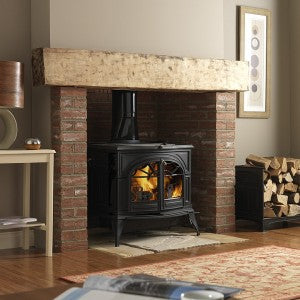
All The Gear But No Idea
Share
American fridge freezers, self-cleaning ovens and wood burning stoves are among the items homeowners most aspire to own according to a study released today*- which also reveals that when consumers do own much hyped products they don’t necessarily know how to use them.
The research, commissioned by The Stove Industry Alliance, found that while eight in ten (83%) of us dream of buying at least one luxury household item like a robot vacuum cleaner or 3D printer, a fifth (21%) who already own one or more of these aspirational items admit to either not using them or using them infrequently because they’re not sure how to make them work.
We’re guilty too of keeping up with the Jones’s. The study also shows that a third (34%) of us own at least one item we don’t need or bought because of hype or because a friend or family member had one. Yet despite owning these items, less than half of us (40%) bother to research how to use products before making the purchase. 3D printers top the list of items people are least confident using, with half of those who own one saying they're unsure how to use them. Hot on the heels are wood burning stoves with two thirds of those who own one not sure how to work it, robot vacuum cleaners, self-cleaning ovens and home cinema systems.
With a fifth (21%) of respondents saying they aspire to have a wood burning stove, Dennis Milligan, spokesperson from The Stove Industry Alliance, commented: “It’s human nature to want to own the most ‘of the moment products’ and there’s perhaps no better example of a product that has had a real renaissance in recent years than wood burning stoves. Our figures show that last year, some 200,000 stoves were sold in the UK and it’s easy to see why. Not only do they look good but they’re proven to be one of the most environmentally friendly space heaters.”
“What this research shows however is, as a nation, we have forgotten how to burn wood. Taking a few minutes to read the manufacturer’s instructions will pay dividends.”
The research also shows that we’re quick to give up on how to use items with a third (31%) trying to get something to work for less than an hour and a similar number (34%) only trying for up to two hours.
When it comes to seeking help we’re more likely to go online than speak to a spouse or family member with 57% saying online is the first port of call, and a stubborn 7% refusing to look for help from any source at all!
Liz Ransome from Which? commented: “It’s easy to get caught up in the hype around a desirable product, but how worthwhile it is depends on whether you really need the features it offers - and whether it actually excels at the job you’ve bought it for. Based on rigorous lab tests, Which? provides independent buying advice and reviews on everything from range cookers to food processors, to reveal the very best value products that pair style with substance. Our buying guides and videos, with insider tips on what features our tests have found to be truly helpful, are a good place to start.”
- Ends -
Suggested box out: step by step guide on wood burning stove purchase and usage
Lighting a stove
Lighting a stove is the most crucial phase. Overloading the stove with logs or using wet wood can generate excessive smoke. Lighting the fire is simple so long as a few basic rules are followed. Start by fully opening the Primary and AirWash controls on the stove. Build the fire slowly. Start with dry kindling and add dry logs as the fire catches. Leave the door open until the fire is established. Then close the door and the Primary Air Control and use the Air Wash to regulate the fire.
Choosing the right wood
It is very important that wood is dried before burning; otherwise much of the energy created while burning is wasted in burning off water content and producing steam. Freshly harvested wood contains a naturally high amount of water, between 65-90% depending on the species. It is recommended that wood is dried or seasoned for at least a year, and preferably two. Removing the water is known as seasoning.
You can dry your own wood in a simple wood store or buy seasoned wood from your supplier. Kiln dried is the best with a moisture content of less than 20%. The moisture content of seasoned logs can vary with average moisture contents between 30% and 50%.
Hardwood is better than softwood, because it burns slower. Both types have similar calorific values but the density of softwood is approximately half that of hardwood, which results in it burning twice as fast. So basically you will need two softwood logs for one hardwood log. Hardwoods are any broad leafed deciduous tree and softwood is conifers.
Never buy wood by weight, as this can mean that you are paying for water. Always buy logs by volume.
Choosing the right stove
The starting point is whether you want to heat a single room or the whole house and whether or not you live in a smoke control area. There is a wide variety of styles to suit all tastes from the traditional to very contemporary. Matching the heat output of a stove with the room it is going to heat is very important and it is best to take advice on this. Most stove retailers are very knowledgeable and willing to give advice. Look for the CE mark. It is now compulsory to have a CE mark.
The HETAS Guide is a handy way to check the pedigree of a stove but it is not mandatory to be in the guide and some of the best European manufacturers are not in it. Check the efficiency of the stove. The better stoves have efficiencies in excess of 70% and some more than 80%. The efficiency reflects the amount of heat being delivered into the room. Increasingly, people are opting for a DEFRA exempt stove, when they don’t live in a smoke control zone because they know that a DEFRA Exempt stove will have satisfied even more stringent emission tests for air quality.
Installing a stove is not a DIY job and a competent installer should be engaged. HETAS runs the largest competent persons scheme for installers and works closely with the industry to improve standards. A competent person can certify the installation safe. Otherwise the installation must be inspected and approved by Building Control.
Notes to editors:
*Study of 1,000 homeowners across the UK, conducted 16th-19th September 2014
For comprehensive information about wood burning stoves, visit the Stove Industry Alliance website for clear, consumer guidance on how to operate a stove and burn wood effectively. Visit the SIA website, www.stoveindustryalliance.com/howtolightafire/ for straightforward procedures for lighting and refuelling a wood burning stove. Another good source of information is the Which guide on how to buy a stove: http://www.which.co.uk/energy/creating-an-energy-saving-home/guides/wood-burning-stoves/
